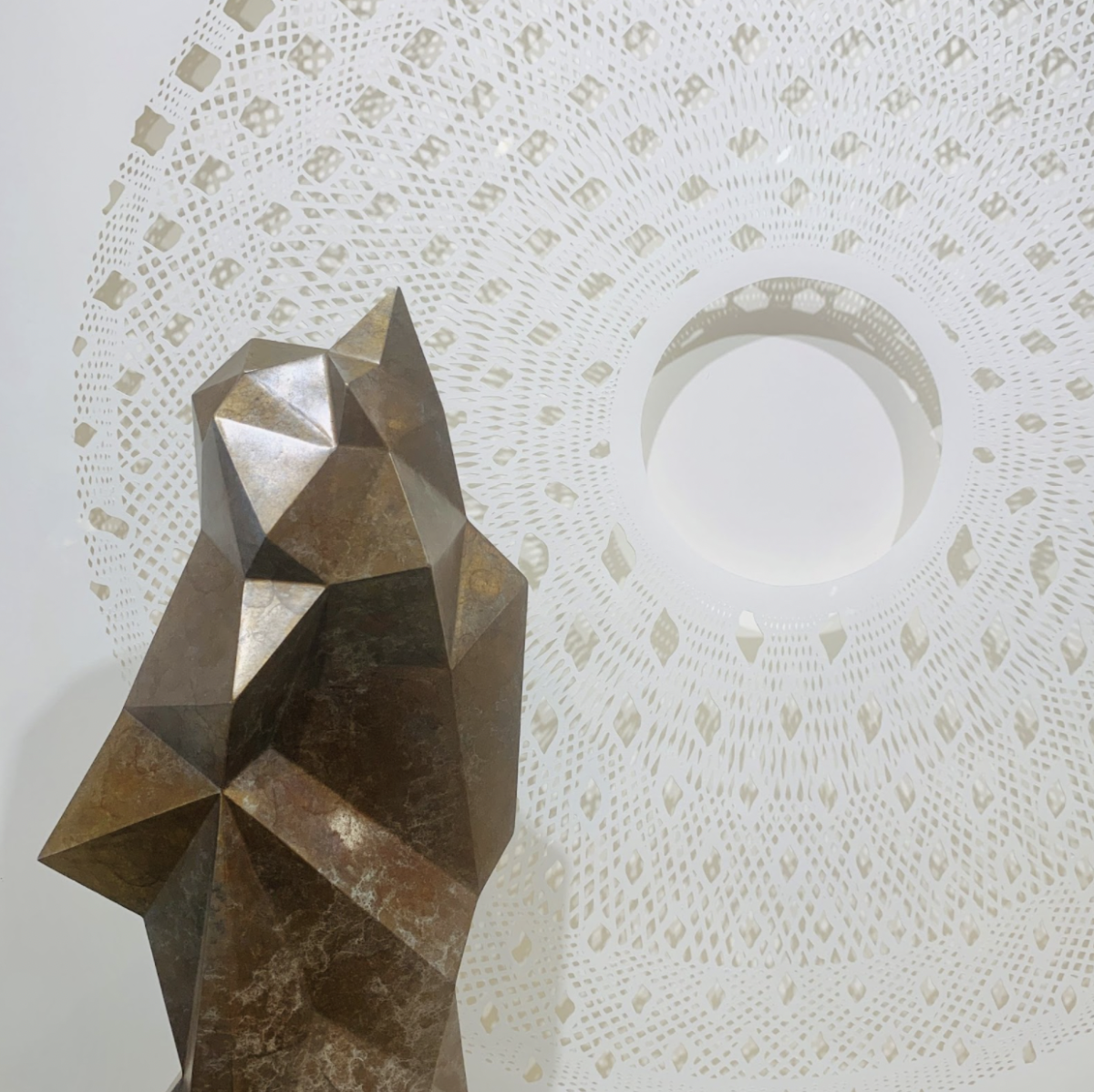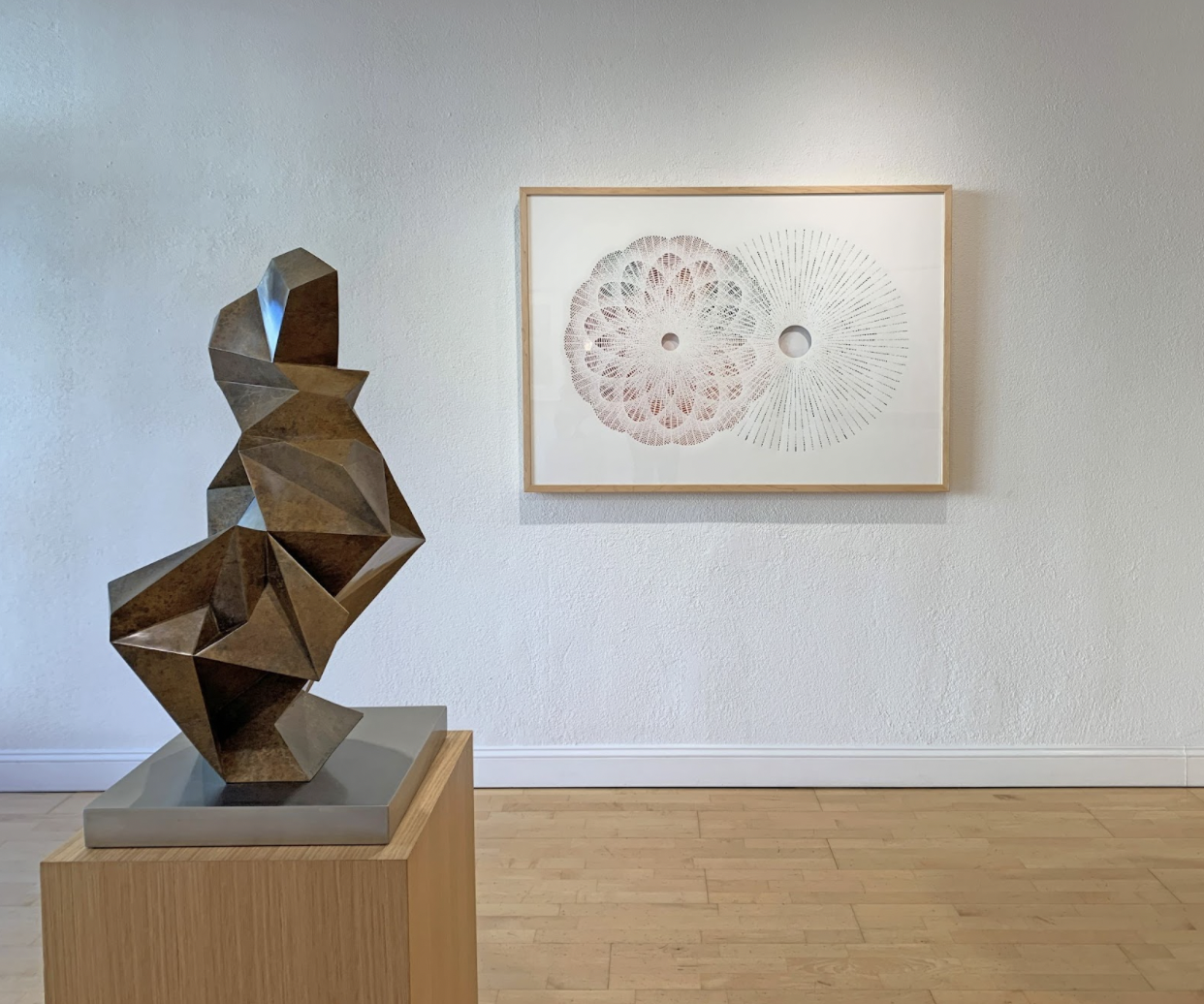Based in Northern California, long-time friends Tahiti Pehrson, a paper-cut artist, and Jud Bergeron, a bronze cast sculptor, recently showcased their new body of work at the Bryant Street Gallery in downtown Palo Alto, one of the few fine arts galleries within biking distance from campus.
Jud Bergeron’s geometric, hard-edged bronze casts are unmistakably bold yet simultaneously meditative. The large, geometric sculptures are built using molds based on cardboard models to cast bronze. Bergeron’s patina development on his casts is fantastic; their clever placement complements the strong gestures of the sculpture while also creating slight color variations. Light reflects off the different planes of the geometric sculpture, making Bergeron’s casts appear ephemeral, despite the inherent permanence of metal sculptures.
Similarly, what drew me to Pehrson’s paper-cuts was their temporal quality and interplay of light. The intricate cuts are meticulously hand-crafted; the barely noticeable traces of human error on the creases of some cuts function as a “proof of work,” evidence of the labor that underlies the craft. Pehrson’s masterful manipulation of light seems both serene and daring as the pieces explore different shapes and dimensions, all showcasing the possibility of beauty in casted shadows.

In “Discussions From the Cave,” Pehrson refreshingly departs from white-on-white paper-cuts. Glimpses of the expressively painted acrylic back panel seep through the incisions of a delicate-as-ever repetitive paper-cut pattern. Perhaps the colors represent a fresh interpretation of ‘lightness of being,’ a seemingly natural progression for the artist, who has been mastering his craft for 15 years. For what is white light, if not a combination of iridescence?
Jeanne Vadeboncoeur, the manager of Bryant Street Gallery, detailed the process of putting together the showcase, saying that the gallery worked to ensure that there was “a lot of synergy between the work.” The two-person exhibit came about out of a deep mutual respect between the artists and the longing to become a part of a community again, after much struggle in the COVID-19 era.
“You produce your work in your studio by yourself, and when you’re in there, you’re having all these thoughts,” Pehrson said, “and then you bring it into the gallery; you kind of come out of the cave in flight.”
Pehrson’s paper-cuts and Bergeron’s casts work in a quiet conversation with one another, laborious whispering that strives for beauty. Bergeron’s bronze casts are rigid in their appearance but softened by the delicate patina that he was able to create, a bold statement about the calmness of creation; Pehrson’s paper-cuts use their gorgeous shadows to feel ephemeral and sensitive.
“I was thinking of the context of his work while I was making these pieces,” said Pehrson, referring to Bergeron, as he explained how having a two-person show motivated his art.
Karen Imperial, the owner of the gallery, told The Daily about the behind-the-scenes work involved with each showing, going back to the firm’s roots as a picture framing company in New York.
“We frame them so that they have depth so that you can see, you know, shades of shadows and things that work,” Imperial said.
Building on their history in the framing business, the gallery made careful curatorial choices when displaying the art, which helped exemplify the techniques and beauty of Pehrson’s works. Many of the frames used for the show are customized to best highlight the paper-cut pieces.
Bryant Street Gallery has been around for more than 25 years, and Imperial said the secret to their success is to recognize that the business of art is ultimately the business of people; it is about the relationships between the artists and the gallery.
“I can make some suggestions, and then they take it or not because I’m out in the world and they’re in their studios,” Imperial said.
Gallerists routinely interact with clients and patrons who support artists, in turn gaining a sense of what work sells well. They act as support systems and mentors for emerging artists to help them generate a financially sustainable practice.
“I like process-based work like [Bergeron’s and Pehrson’s], and I like things that are aesthetically pleasing,” Imperial laughed, “I’m never going to be one of those avant-garde kinds of gals. I’m just not; it’s not me. It’s not my clientele.”
“Discussions in The Cave” is an incredible show that I highly recommend. The art on display captures the stillness of the world and allows guests to cherish these rare, precious moments of silence. Viewers can visit “Discussions in The Cave” at Bryant Street Gallery until Jan. 31.
Editor’s Note: This article is a review and includes subjective opinions, thoughts and critiques.
